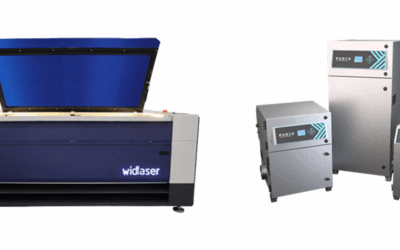Laser Tube Buying Guide
When choosing a laser cutting, engraving & marking machine there are three main options when it comes to tube choice, Glass Tube, Ceramic Tube or Fiber Tube that we currently supply.
In this buying guide we explain the main differences between the different types of tubes that are available and which system is best for your business and material processing requirements.
What Are Ceramic CO2 Laser Tubes?
Ceramic (aka Metal) RF CO2 Tubes
Users of machines that utilise ceramic tubes are often full commercial operations that require media to be processed quickly, precisely and efficiently. Ceramic machines are often used for long periods every day for high volume manufacturing purposes.
Ceramic RF (Radio Frequency) Tubes last far longer than standard CO2 Glass DC tubes, you are looking at a potential lifespan of 5+ years depending on use and maintenance of the machine as opposed to approximately 6 months with standard Glass DC CO2 tubes.
Ceramic tubes are more environmentally friendly then CO2 tubes as they can be sent back to the manufacturer to be renewed unlike glass tubes which once spent have to be disposed of.
Ceramic RF tubes are more powerful than the Glass DC equivalent and are commonly air cooled which means they are not prone to frost damage like the CO2 Glass tubes which are fluid cooled.
RF tubes produce their photonic beam immediately from the moment you flick the switch, there is no wait time like with the glass version. RF tubes produce a fast repeatability rate which in turn allows them to produce finer and more intricate work than glass tubes and provide a much faster media procesing time.
Points Of Interest:
- System Cooling Type: Air
- Common Lifespan: Approx: 40,000 hrs (5+ Years)
- Laser Pulse Rate: Fast
- Can The Tube Be Renewed: Yes
Common Uses For Cermic Laser Systems:
- Cutting: Rigid Type Materials Such As Acrylic, Wood, MDF
- Engraving: Rigid Type Materials Such As Acrylic, Wood, MDF
- Marking: Rigid Type Materials Including Coated Metals
View all Ceramic Tube Systems
What Are Glass CO2 Laser Tubes?
Glass CO2 DC Tubes
Users of machines that utilise CO2 tubes are often creating bespoke smaller volume products that have been personalised or for prototyping parts for future mass manufacture. CO2 machines are often used for shorter periods of time to create shorter run or one-off projects to users who create items to sell on platforms such as Etsy, Shopify or within smaller private business outlets and markets. CO2 machines are also incredibly popular within educational institutions and design departments.
CO2 Glass tubes are filled with a mixture of gasses (Carbon Dioxide | Helium | Nitrogen | Hydrogen | Xenon) and once electricity is sent through the tube it agitates & excites these gasses which creates a direct electrical discharge.
This discharge generates an invisible photonic laser beam that bounces around the tube until the desired level of charge has been achieved which then creates the photonic light beam (laser) that then leaves the laser tube.
The created photonic laser beam is infrared which means it is invisible to the naked eye but extremely powerful and can then be used to cut, engrave or mark material.
All Glass CO2 DC Tubes are cooled using liquid which means they can be prone to frost damage should the system be used / stored in a cool environment (such as an uninsulated shed or garage), care and prior consideration should be given in regards to where the laser system is located at time of install to help to prevent this from happening and to maximise the full lifespan of the tube.
Points Of Interest:
- Tube Cooling Type: Liquid
- Common Lifespan: Approx; 4000 hrs (6 Months)
- Laser Pulse Rate: Slow
- Can The Tube Be Renewed: No
Common Uses For CO2 Laser Systems:
- Cutting: Rigid Type Materials Such As Acrylic, Wood, MDF
- Engraving: Rigid Type Materials Such As Acrylic, Wood, MDF
- Marking: Rigid Type Materials Including Coated Metals
View all Glass Tube CO2 Systems
What Are Fiber Laser Tubes?
Fiber Tubes
Users of machines that utilise Fiber powered laser machines use them to mark materials only. This method is popular within industires that specialise in personalising promotion products or creating identification tags using metal plates.
Fiber tubes work by creating and pumping light from laser diodes. The diodes create light that is then transferred through a fiber optic cable through to an amplifier to increase their intensity.
Once the light has been amplified in the laser cavity is is optimised into a spcific wavelength that can then be shaped into a stright beam.
The beam that a Fiber System creates means it is specifically used to mark onto most materials including uncoated metals which CO2 or Ceramic powered laser systems are unable to do.
Fiber systems can be operated in either continuous or pulsed modes, the WidLaser F150 that we supply operates using a pulsed mode operation.
Points Of Interest:
- Tube Cooling Type: Ait Cooling
- Common Lifespan: Approx; 100,000 Hours
- Laser Pulse Rate: Up To 100khz
- Can The Tube Be Renewed: No
Fiber Laser Systems Mark Onto:
- Steel
- Aluminium
- Brass
- Copper
View all Fiber Laser Systems
The Mutoh XpertJet 1682UR is now available with the newly introduced US81 inks
Expressive and Sustainable Mutoh’s 64-inch high-performance UV LED...
Graphtec GB and Purex International Limited
If you’re using a CO₂ laser cutter or engraver - whether in a school,...
The Graphtec CE8000 plotter provides an accurate and reliable solution for DTF applications
DTF technology has transformed the market for garment and textile decoration....




